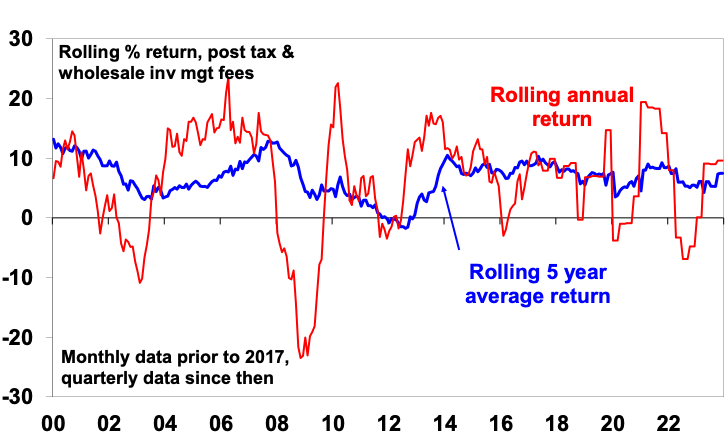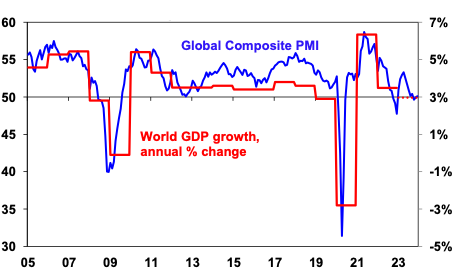Introduction
After poor returns in 2022 on the back of high and rising inflation, a surge in interest rates, the invasion of Ukraine and recession worries, 2023 was a far better year for investors as inflation fell and investment markets anticipated lower interest rates ahead. This saw average balanced growth superannuation funds return around 9.5% more than making up for the 4.8% loss in 2022, as both shares and bonds rallied. Over the last five years, they returned around 7.5% pa, which exceeded inflation.

Balanced growth superannuation fund returns
Source: Mercer Investment Consulting, Morningstar, AMP
Can the rebound continue or will markets have a rough year. Here is a simple point form summary of key insights and views on the outlook.
Five key themes from 2023
-
Stronger than feared growth. Despite fears recession was inevitable, on the back of rate hikes, it’s been avoided so far, helped by saving buffers, reopening boosts and some labour hoarding.
-
Disinflation. Inflation across major countries fell from peaks of 8 to 11% in 2022 to around 3 to 5% as supply pressure and demand eased.
-
Peak interest rates. Most major central bank policy rates look to have peaked and this probably includes the RBA’s cash rate.
-
Geopolitical threats proved not to be as worrying as feared.
-
Artificial intelligence hit the big time after the launch of Chat GPT. This helped tech stocks (mostly US) tech stocks reverse their 2022 slump.
Five lessons for investors from 2023
-
Monetary policy still works in controlling inflation – the lags may be long and variable but this time was not really different. Of course, an easing in supply chain disruptions helped and there is still a way to go.
-
Don’t ignore population growth – a surge in immigration played a big role in pushing home prices back up and avoiding recession in Australia.
-
Timing markets is hard – it was easy to be gloomy a year ago with a long worry list and shares plunging into October but timing markets on the back of this was a loser as shares surged, putting in strong returns.
-
Geopolitics matters – but it’s hard to predict (eg, Hamas’ attacks on Israel) and the impact can often be less than feared, with the world learning to live with the war in Ukraine and the Israel/Hamas war not (yet) causing a surge in oil prices.
-
Turn down the noise – investors are being hit with often irrelevant, low quality & conflicting information which boosts uncertainty. The key is to turn down the noise and stick to a long-term strategy.
The three big worries for 2024
-
Inflation is still too high and its decline is likely to remain bumpy – so central banks could still have another hawkish turn and even if not there is a high risk that rate cuts may come later than markets expect.
-
The risk of recession is high. It’s hard to see the biggest rate hiking cycle since the 1980s not having a major impact and the risks are already evident in tighter US lending standards, falling lending in Europe and stalling consumer spending in Australia. Risks around the Chinese economy and property sector also remain high.
-
Geopolitical risk is high: with half the world’s population seeing elections including the US, EU & India; the US Government could have a shutdown starting 19 January & could have another divisive Biden v Trump presidential election; the result of Taiwan’s 13 January election could see an easing or an escalation of tensions with China depending who wins; the war in Ukraine is continuing; and there is a high risk the Israel/Hamas war could spread, threatening oil supplies, particularly with Iran’s proxy Houthi rebels disrupting Red Sea shipping.
Four reasons for optimism
-
Inflation has eased sharply to around 3% in major industrial countries and around 5% in Australia and is likely to continue to fall as: supply chain pressures have eased; demand is cooling; and labour markets are easing. This includes in Australia which lagged US inflation on the way up and is just doing so again on the way down.
-
We expect the ECB to start cutting rates in March, followed by the Fed and BoC in the June quarter. While there is still a high risk of one more hike in Australia in February, falling inflation should head this off so our base case is that the RBA has peaked ahead of rate cuts from June, taking the cash rate down to 3.6% by year end. Just as rate hikes were bad for shares in 2022, rate cuts should ultimately be positive.
-
While recession is a high risk and markets are no longer priced for it, if it does occur it should be mild: most countries have not seen a spending boom that needs to be unwound; in Australia consumer spending, housing investment and business investment are not running at excessive levels relative to GDP; and Chinese growth is soft and property sector risks are high, but it’s likely to target roughly 5% GDP growth again and back this up with fiscal stimulus if need be.
-
Finally, while there’s lots of geopolitical risks they may not turn out so badly: the US has a strong incentive to avoid an escalation in the Israel/Hamas war; the Ukraine war could turn into a frozen conflict; & elections won’t necessarily go in an adverse direction for markets. In relation to the US, the presidential election year normally sees average share returns and Trump could falter before the election.
Key views on markets for 2024
Easing inflation pressures, central banks moving to cut rates and prospects for stronger growth in 2025 should make for okay returns in 2024. However, with growth still slowing, shares historically tending to fall during the initial phase of rate cuts, a very high risk of recession and investors and share market valuations no longer positioned for recession, it’s likely to be a rougher and more constrained ride than in 2023. We expect balanced growth super funds to return around 5.3% this year.
-
Global shares are expected to return a far more constrained 7%. The first half could be rough as growth weakens, but shares should ultimately benefit from rate cuts and lower bond yields and the anticipation of stronger growth later in the year and in 2025.
-
Australian shares are likely to outperform global shares, after underperforming in 2023 helped by somewhat more attractive valuations. A recession could threaten this though so it’s hard to have a strong view. Expect the ASX 200 to end 2024 at around 7,900 points (revised up from our initial target of 7500).
-
Bonds are likely to provide returns around running yield or a bit more, as inflation slows, and central banks cut rates.
-
Unlisted commercial property returns are likely to be negative again due to the lagged impact of high bond yields & working from home.
-
Australian home prices are likely to fall 3-5% as high rates hit demand & unemployment rises. The supply shortfall should prevent a sharper fall & expect a wide dispersion. Rate cuts will help later in the year.
-
Cash and bank deposits are expected to provide returns of over 4%.
-
A rising trend in the $A is likely taking it to $US0.72, due to a fall in the overvalued $US and the Fed cutting rates more than the RBA.
Five points on Bitcoin
-
Bitcoin rose 157% through 2023.
-
However, this followed a 64% fall in 2022, so it remains very volatile.
-
It and other crypto currencies remain highly geared to US shares and expectations for interest rates – explaining its sharp fall in 2022 when shares fell and rates rose and rebound with shares in 2023.
-
Bitcoin is yet to find a clear use (beyond as something to speculate in) making it very hard to value fundamentally – unlike, say, property which provides rents and shares which provide earnings. Recent gains owe partly to excitement around this year’s “halving” (in the amount of Bitcoin that miners receive) and anticipation of an exchange traded fund that can invest in Bitcoin – rather than developments in its use.
-
There is value in blockchain technology (for decentralised finance, contracts, etc) which is positive for cryptocurrencies like Ethereum, but this is hard to value.
Five things to watch
-
Inflation – if it fails to continue falling as we expect, central banks will be more hawkish than we are allowing for, risking deep recession.
-
Recession – a mild recession should be manageable but a deep recession will mean significant downside in shares. So far global business conditions PMIs are soft but consistent with okay growth.
Global Composite PMI vs World GDP

Source: Bloomberg, IMF, AMP
-
The Chinese economy – China’s property sector is continuing to struggle and without measures to support consumers this could hurt its economy with a flow on to demand for Australian exports.
-
Geopolitics – the key risks relate to Taiwan, a possible expansion of the Israel/Hamas war and the US Presidential election.
-
The Australian consumer – consumer spending has slowed sharply and risks stalling as a result of cost-of-living pressures, high interest rates and higher unemployment.
Nine things investors should remember
-
Make the most of compound interest to grow wealth. Saving regularly in growth assets can grow wealth significantly over long periods. Using the “rule of 72”, it will take 16 years to double an asset’s value if it returns 4.5% pa (ie, 72/4.5) but only 9 yrs if the asset returns 8% pa.
-
Don’t get thrown off by the cycle. Falls in asset markets can throw investors of a well-considered strategy, destroying potential wealth.
-
Invest for the long-term. Given the difficulty in timing market moves, for most it’s best to get a long-term plan that suits your wealth, age and risk tolerance and stick to it.
-
Diversify. Don’t put all your eggs in one basket.
-
Turn down the noise. This is critical with the information overload coming from social and mainstream media, with plenty of clickbait.
-
Buy low, sell high. The cheaper you buy an asset, the higher its prospective return will likely be and vice versa.
-
Avoid the crowd at extremes. Don’t get sucked into euphoria or doom and gloom around an asset.
-
Focus on investments you understand offering sustainable cash flow. If it looks dodgy, hard to understand or has to be justified by odd valuations or lots of debt, then stay away. There is no free lunch!
-
Seek advice. Investing can get complicated and its often hard to stick to a long-term investment strategy on your own.
Dr Shane Oliver – Head of Investment Strategy and Chief Economist, AMP
Source: AMP Capital January 2024
Important note: While every care has been taken in the preparation of this document, AMP Capital Investors Limited (ABN 59 001 777 591, AFSL 232497) and AMP Capital Funds Management Limited (ABN 15 159 557 721, AFSL 426455) make no representations or warranties as to the accuracy or completeness of any statement in it including, without limitation, any forecasts. Past performance is not a reliable indicator of future performance. This document has been prepared for the purpose of providing general information, without taking account of any particular investor’s objectives, financial situation or needs. An investor should, before making any investment decisions, consider the appropriateness of the information in this document, and seek professional advice, having regard to the investor’s objectives, financial situation and needs. This document is solely for the use of the party to whom it is provided.




